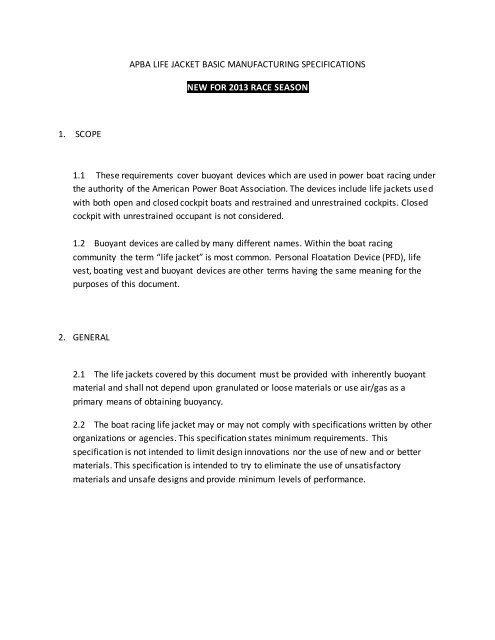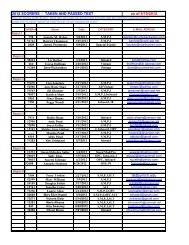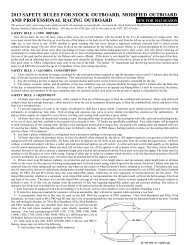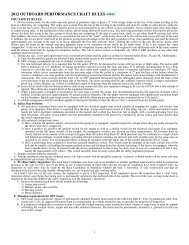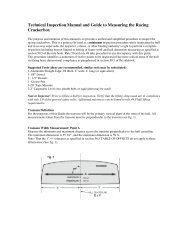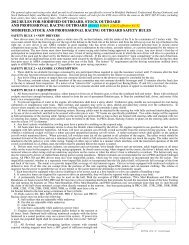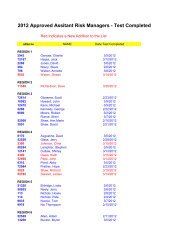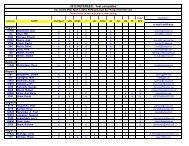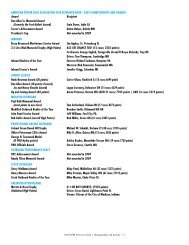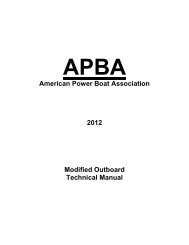2013-APBA LIFE JACKET BASIC MANUFACTURING ...
2013-APBA LIFE JACKET BASIC MANUFACTURING ...
2013-APBA LIFE JACKET BASIC MANUFACTURING ...
Create successful ePaper yourself
Turn your PDF publications into a flip-book with our unique Google optimized e-Paper software.
3. DEFINITIONS3.1 For the purpose of this specification, the following terms shall apply:3.2 BUOYANT DEVICES (Life Jackets) The following defines life jackets covered bythese requirements:A. Type A. A device intended to turn an unconscious person from face downposition to a position where the wearer’s respiration is not impaired. A Type ALife Jacket is designed to be used in an open and unrestrained cockpit.B. Type B. A device intended to be worn by a person in a racing cockpit wherethe wearer is restrained in the cockpit and other supplemental life supportsystems are not necessarily present.C. Type C. A device intended to be worn by a person in a racing cockpit wherethe wearer is restrained in the cockpit and other supplemental life supportsystems requiring life jackets accommodations are present.3.3 BUOANCY: The amount of buoyant material required to be available to thewearer. Any part of the life jacket or attachments which will not float must haveadditional buoyant material added to the life jacket to compensate for the loss ofbuoyancy.3.4 CLOSURESA. Primary: A means of securing the device on the body that causes the deviceto function in its intended manner without employing any other means offastening the device to the body.B. Secondary: A closure that, when used on the device by itself, does not makethe device appear to be donned as intended and is not required to be closed tocomply with the requirements of this document.3.5 FOAM: A closed cell foamed polymeric material.3.6 LOCK TYPE STITCH: A stitch that will not unravel when a force is applied in thedirection if the seam on any of the threads forming the stitch.3.7 SEAM: A joint consisting of a sequence or series of stitches uniting two or morepieces of material.
3.8 SKID COLLAR: A device which is an integral part of a Type A Life Jacket whichdeflects water from the base of a helmet upon a feet first entry by the wearer.4. COMMON FACTORS4.1 All racing life jackets shall be designed for the purpose of racing and shall possessthe following:4.2 No “fungus nutrient” materials (cotton, linen, silk, hemp, sisal, cork etc.) may beused.4.3 Metals shall be used in combinations which are galvanically compatible.4.4 All fabrics shall be Cordura Nylon (brand name), polyurethane, backed or equaland made with a minimum 400 denier fabric with the following exception:A. Type A Life Jackets to be used on boats whose top speed exceeds 100 mphmust have an outer cover made of 1000 denier nylon minimum and an innercover of 410 denier nylon minimum. These jackets will be called Type A-100.4.5 No monofilament thread shall be used.4.6 No materials shall be used which will be degraded more than 2% by prolongedexposure to either fresh or salt water.4.7 All structural seams shall use a lock type stitch, type 301, as defined in FederalStandard 751 or better and as illustrated below:FIG. 11 Stitch Type 301NOTE 1—This type of stitch shall be formed with two threads: one needle thread, A, and one bobbin thread, B. A loop ofthread A shall be passed through the material and interlaced with thread B. Thread A shall be pulled back so that theinterlacing shall be midway between surfaces of the material or materials being sewn.
4.8 All materials used in the fabrication of racing life jackets shall withstand storagetemperatures from -30 degrees F to +130 degrees F without degradation.4.9 The manufactures or recertifiers name, the life jacket Type (A, A-100, B or C) andthe date of manufacture or recertification shall be permanently marked on the lifejacket.The marking must be visible by looking on either the inside or outside of the jacket. Themarking letters must be at least ¼ inch high and the method of marking must befunctional throughout the life of the jacket. Warnings against any cleaning process thatmay make the markings illegible must be provided.4.10 Strap ends must be doubled and stitched or dipped so as to not be able tounthread through the buckle or snap.4.11 Velcro shall not be used as a primary means of closure, but may be used as asecondary means of closure. Velcro may be used on non critical closures and strap endsto stop wind flap.4.12 All material used in racing life jackets must be oil, grease, gasoline and alcoholresistant.4.13 The design of the life jacket must be such that the proper method of donning andwearing the jacket is obvious and no special method of training is required for properuse. Manufacturer instruction sheets are encouraged.4.14 Secondary flotation systems using air/gas are permitted so long as the minimumbuoyancy requirement is met using permanent type buoyant materials.4.15 Impact material is required in all A-100 jackets. The impact material shall be0.06 inch low or medium density polypropylene or equal type material. Thepolypropylene must be the layer immediately under the outer cover and the flotationmaterial must be against the inner cover.4.16 Parachutes or other devices attached to the life jacket may be required byindividual categories or classes.4.17 All life jackets shall have at least 70% of the upper surfaces, both front and back,international orange or yellow in color.
5. TYPE A <strong>LIFE</strong> <strong>JACKET</strong>S ( Includes Type A & A-100)5.1 Type A Life Jackets shall have buckle type straps across all primary closures.5.2 Skid Collars, when used, shall be as follows:A. The skid collar shall be integral to the life jacket by being stitched in place.B. The skid collar shall be covered with the same fabric as the rest of the lifejacket.C. The skid collar shall have ¼” thick Sentinel Olefoam (brand name) or equal asa core. The area of required coverage shall be from 120 degrees to 230degrees when measured from the midsaggital plane.D. The skid collar shall be sufficiently tall to provide some overlap of the helmetwhen the wearer is standing in a vertical, erect, relaxed stance.E. Additional flotation and / or padding in the skid collar are permissible.F. The skid collar must be international orange or yellow on all surfaces.5.3 The design of the life jacket shall be such that body padding and impactprotection shall cover the front back and sides of the torso.5.4 Jackets equipped with leg straps shall not use a waist strap as a primary meansof attachment to the jacket. The leg straps must take their primary stress over thewearer’s shoulders.5.5 The flotation buoyancy for Type A Life Jackets shall be a minimum of 18 pounds.5.6 The flotation material must be so distributed so as to have at least 15% moreflotation on one side than is on the other side laterally. Note: Normally the greaterflotation will be on the left side of the jacket.5.7 All A-100 life jackets will contain impact material.
6. TYPE B <strong>LIFE</strong> <strong>JACKET</strong>S6.1 Type B Life Jackets shall have straps on each shoulder area which allow a rescuerto have an easy and secure grasp.6.2 Type B Life Jackets shall be designed in such a manner that the currently requiredretention system in the boats shall not be interfered with.6.3 The flotation buoyancy for the Type B jacket is 10 pounds plus or minus onepound.6.4 Type B Lifejackets may be incorporated into a Driving Suit so long as specs 6.1, 6.2 and6.3 are complied with.7. TYPE C <strong>LIFE</strong> <strong>JACKET</strong>S7.1 Type C Life Jackets shall have straps on each shoulder area which allow a rescuerto have an easy and secure grasp.7.2 Type C Life Jackets may be designed to hold or assist in holding other life supportsystems. Any such attachments must be designed in a manner so that there is no, oronly minimal, interference with the current specified restraint system in the boat. Thelife support system attachments must be so designed that they cannot be confused withthe safety belt release mechanism when operated without the aid of eyesight. All lifesupport attachments to the life jacket must be the pull release type.7.3 The flotation buoyancy for the Type C Life Jacket is 10 pounds plus or minus onepound.7.4 Type C Life Jackets may be incorporated into a driving suit so long as the materialand color requirements of paragraph 4.4 and 4.17 are complied with. The areas ofspecial material and color coverage shall be from the upper most surface to the waistexcluding the arms.


